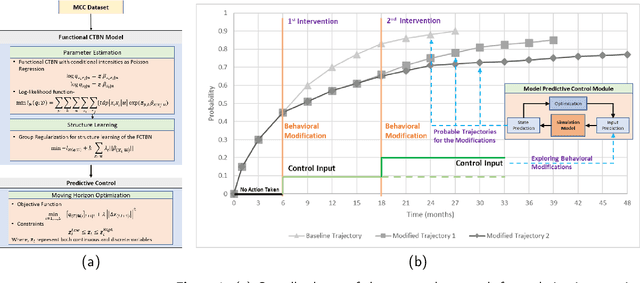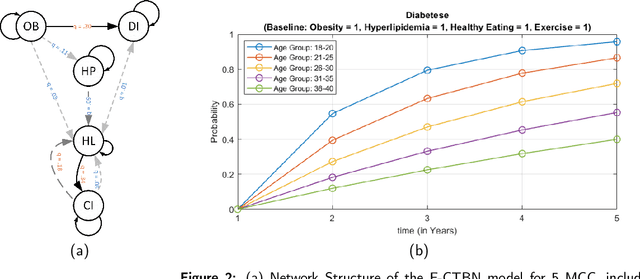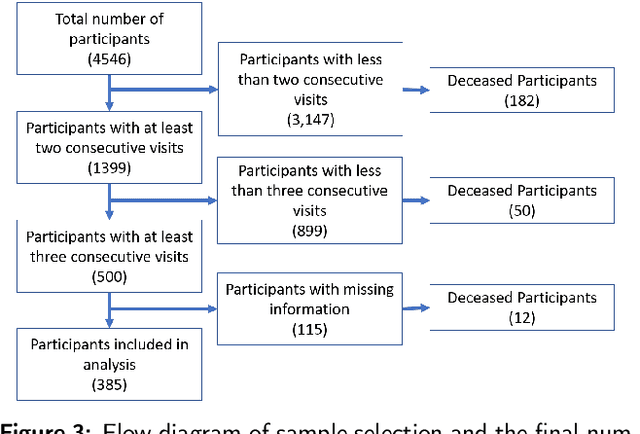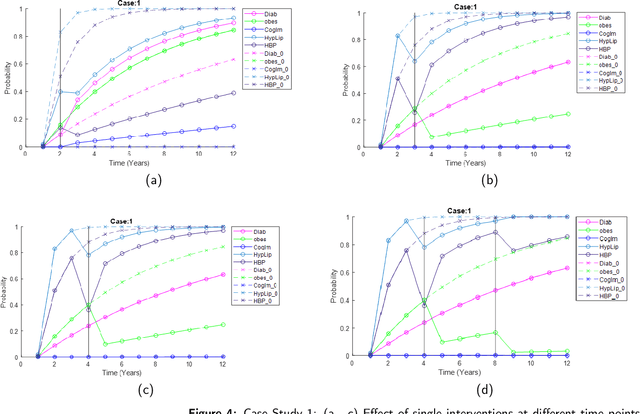Adel Alaeddini
Nurse-in-the-Loop Artificial Intelligence for Precision Management of Type 2 Diabetes in a Clinical Trial Utilizing Transfer-Learned Predictive Digital Twin
Jan 05, 2024Abstract:Background: Type 2 diabetes (T2D) is a prevalent chronic disease with a significant risk of serious health complications and negative impacts on the quality of life. Given the impact of individual characteristics and lifestyle on the treatment plan and patient outcomes, it is crucial to develop precise and personalized management strategies. Artificial intelligence (AI) provides great promise in combining patterns from various data sources with nurses' expertise to achieve optimal care. Methods: This is a 6-month ancillary study among T2D patients (n = 20, age = 57 +- 10). Participants were randomly assigned to an intervention (AI, n=10) group to receive daily AI-generated individualized feedback or a control group without receiving the daily feedback (non-AI, n=10) in the last three months. The study developed an online nurse-in-the-loop predictive control (ONLC) model that utilizes a predictive digital twin (PDT). The PDT was developed using a transfer-learning-based Artificial Neural Network. The PDT was trained on participants self-monitoring data (weight, food logs, physical activity, glucose) from the first three months, and the online control algorithm applied particle swarm optimization to identify impactful behavioral changes for maintaining the patient's glucose and weight levels for the next three months. The ONLC provided the intervention group with individualized feedback and recommendations via text messages. The PDT was re-trained weekly to improve its performance. Findings: The trained ONLC model achieved >=80% prediction accuracy across all patients while the model was tuned online. Participants in the intervention group exhibited a trend of improved daily steps and stable or improved total caloric and total carb intake as recommended.
Discrimination of Radiologists Utilizing Eye-Tracking Technology and Machine Learning: A Case Study
Aug 04, 2023



Abstract:Perception-related errors comprise most diagnostic mistakes in radiology. To mitigate this problem, radiologists employ personalized and high-dimensional visual search strategies, otherwise known as search patterns. Qualitative descriptions of these search patterns, which involve the physician verbalizing or annotating the order he/she analyzes the image, can be unreliable due to discrepancies in what is reported versus the actual visual patterns. This discrepancy can interfere with quality improvement interventions and negatively impact patient care. This study presents a novel discretized feature encoding based on spatiotemporal binning of fixation data for efficient geometric alignment and temporal ordering of eye movement when reading chest X-rays. The encoded features of the eye-fixation data are employed by machine learning classifiers to discriminate between faculty and trainee radiologists. We include a clinical trial case study utilizing the Area Under the Curve (AUC), Accuracy, F1, Sensitivity, and Specificity metrics for class separability to evaluate the discriminability between the two subjects in regard to their level of experience. We then compare the classification performance to state-of-the-art methodologies. A repeatability experiment using a separate dataset, experimental protocol, and eye tracker was also performed using eight subjects to evaluate the robustness of the proposed approach. The numerical results from both experiments demonstrate that classifiers employing the proposed feature encoding methods outperform the current state-of-the-art in differentiating between radiologists in terms of experience level. This signifies the potential impact of the proposed method for identifying radiologists' level of expertise and those who would benefit from additional training.
Incorporation of Eye-Tracking and Gaze Feedback to Characterize and Improve Radiologist Search Patterns of Chest X-rays: A Randomized Controlled Clinical Trial
Aug 04, 2023Abstract:Diagnostic errors in radiology often occur due to incomplete visual assessments by radiologists, despite their knowledge of predicting disease classes. This insufficiency is possibly linked to the absence of required training in search patterns. Additionally, radiologists lack consistent feedback on their visual search patterns, relying on ad-hoc strategies and peer input to minimize errors and enhance efficiency, leading to suboptimal patterns and potential false negatives. This study aimed to use eye-tracking technology to analyze radiologist search patterns, quantify performance using established metrics, and assess the impact of an automated feedback-driven educational framework on detection accuracy. Ten residents participated in a controlled trial focused on detecting suspicious pulmonary nodules. They were divided into an intervention group (received automated feedback) and a control group. Results showed that the intervention group exhibited a 38.89% absolute improvement in detecting suspicious-for-cancer nodules, surpassing the control group's improvement (5.56%, p-value=0.006). Improvement was more rapid over the four training sessions (p-value=0.0001). However, other metrics such as speed, search pattern heterogeneity, distractions, and coverage did not show significant changes. In conclusion, implementing an automated feedback-driven educational framework improved radiologist accuracy in detecting suspicious nodules. The study underscores the potential of such systems in enhancing diagnostic performance and reducing errors. Further research and broader implementation are needed to consolidate these promising results and develop effective training strategies for radiologists, ultimately benefiting patient outcomes.
A Model Predictive Control Functional Continuous Time Bayesian Network for Self-Management of Multiple Chronic Conditions
May 26, 2022



Abstract:Multiple chronic conditions (MCC) are one of the biggest challenges of modern times. The evolution of MCC follows a complex stochastic process that is influenced by a variety of risk factors, ranging from pre-existing conditions to modifiable lifestyle behavioral factors (e.g. diet, exercise habits, tobacco use, alcohol use, etc.) to non-modifiable socio-demographic factors (e.g., age, gender, education, marital status, etc.). People with MCC are at an increased risk of new chronic conditions and mortality. This paper proposes a model predictive control functional continuous time Bayesian network, an online recursive method to examine the impact of various lifestyle behavioral changes on the emergence trajectories of MCC and generate strategies to minimize the risk of progression of chronic conditions in individual patients. The proposed method is validated based on the Cameron county Hispanic cohort (CCHC) dataset, which has a total of 385 patients. The dataset examines the emergence of 5 chronic conditions (diabetes, obesity, cognitive impairment, hyperlipidemia, and hypertension) based on four modifiable risk factors representing lifestyle behaviors (diet, exercise habits, tobacco use, alcohol use) and four non-modifiable risk factors, including socio-demographic information (age, gender, education, marital status). The proposed method is tested under different scenarios (e.g., age group, the prior existence of MCC), demonstrating the effective intervention strategies for improving the lifestyle behavioral risk factors to offset MCC evolution.
Nonlinear State Space Modeling and Control of the Impact of Patients' Modifiable Lifestyle Behaviors on the Emergence of Multiple Chronic Conditions
Jul 14, 2021Abstract:The emergence and progression of multiple chronic conditions (MCC) over time often form a dynamic network that depends on patient's modifiable risk factors and their interaction with non-modifiable risk factors and existing conditions. Continuous time Bayesian networks (CTBNs) are effective methods for modeling the complex network of MCC relationships over time. However, CTBNs are not able to effectively formulate the dynamic impact of patient's modifiable risk factors on the emergence and progression of MCC. Considering a functional CTBN (FCTBN) to represent the underlying structure of the MCC relationships with respect to individuals' risk factors and existing conditions, we propose a nonlinear state-space model based on Extended Kalman filter (EKF) to capture the dynamics of the patients' modifiable risk factors and existing conditions on the MCC evolution over time. We also develop a tensor control chart to dynamically monitor the effect of changes in the modifiable risk factors of individual patients on the risk of new chronic conditions emergence. We validate the proposed approach based on a combination of simulation and real data from a dataset of 385 patients from Cameron County Hispanic Cohort (CCHC) over multiple years. The dataset examines the emergence of 5 chronic conditions (Diabetes, Obesity, Cognitive Impairment, Hyperlipidemia, and Hypertension) based on 4 modifiable risk factors representing lifestyle behaviors (Diet, Exercise, Smoking Habit, and Drinking Habit) and 3 non-modifiable risk factors, including demographic information (Age, Gender, Education). The results demonstrate the effectiveness of the proposed methodology for dynamic prediction and monitoring of the risk of MCC emergence in individual patients.
A Functional Model for Structure Learning and Parameter Estimation in Continuous Time Bayesian Network: An Application in Identifying Patterns of Multiple Chronic Conditions
Jul 31, 2020



Abstract:Bayesian networks are powerful statistical models to study the probabilistic relationships among set random variables with major applications in disease modeling and prediction. Here, we propose a continuous time Bayesian network with conditional dependencies, represented as Poisson regression, to model the impact of exogenous variables on the conditional dependencies of the network. We also propose an adaptive regularization method with an intuitive early stopping feature based on density based clustering for efficient learning of the structure and parameters of the proposed network. Using a dataset of patients with multiple chronic conditions extracted from electronic health records of the Department of Veterans Affairs we compare the performance of the proposed approach with some of the existing methods in the literature for both short-term (one-year ahead) and long-term (multi-year ahead) predictions. The proposed approach provides a sparse intuitive representation of the complex functional relationships between multiple chronic conditions. It also provides the capability of analyzing multiple disease trajectories over time given any combination of prior conditions.
 Add to Chrome
Add to Chrome Add to Firefox
Add to Firefox Add to Edge
Add to Edge